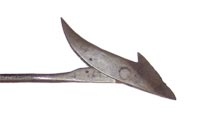
Lesson 2
Supply and Demand: Whales and the Technology of Whaling
- Time Required: 50 minutes
- Curriculum Fits: History, Science
Lesson Overview
In this lesson students will learn about whales and the technology of whaling. They will research sperm, right and bowhead whales and learn why these types of whales were in demand and what resources they provided. Students also will have an opportunity to learn about three different inventions that arose from the need to devise new ways of chasing and capturing whales when those closest to New England were killed off.
Learning Objectives
- Students will recognize that whales varied and represented a limited natural resource.
- Students will understand some of the uses of whale products.
- Students will discover that scarcity of natural resources led to technological advances I whaling g techniques.
- Students will recognize that the demand for whale products changed when consumers' preferences changed and there was substitute product that was significantly cheaper.
- Students will use primary and secondary sources to answer historical questions.
Materials
- photocopies of Whale I. D. Cards
- secondary source: "Whales for Sale" by Rosalie Baker, Footsteps , May/June 1999
- secondary source: this website, Story of Whaling, After the Voyage
- secondary source: this website, About Whales
- secondary source: New Bedford Whaling Museum's "A New Bedford Voyage"
- copies of artifact card for toggle harpoon, from the Artifact section of this website
- copies of glossary cards for tryworks and bark, from the Glossary section of this website
- student worksheets: Six Whales
- student worksheets: Three Whaling Inventions
- kerosene lamp (optional)
- board or easel
- large sheets of chart paper or overhead projector
Preparation
Make sure that there are copies of the articles, glossary and artifact cards for individual students or groups of students.Opportunity to view sections of this website is also needed for thier research. A kerosene lamp will add drama to the presentation.
Proceedure
- Turn out the classroom lights and tell students that before the age of electricity, people needed sources of light. If you have a kerosene lamp, light this and explain that before kerosene was distilled from petroleum, there were not many sources of lamp fuel that burned brightly, weren't smokey, didn't smell and were not highly flamable. Whale oil was the solution. It burned slowly, clearly, and safely. Elplain that candles made from animal fat didn't burn well. They smoked, bent in warm weather, dripped easily, and burned too quickly Adding spermaceti (a liquid fund in the Sperm whale's head) to a tallow candle created a more expensive product, but one that burned for a long time and gave off a clear, almost smokeless, bright light.
- Turn the lights back on and inform students that whale oil was also used for lubricating machinery, manufacturing textiles and rope, and making polishes, varnishes and paint.
- Tell students that before the invention of plastic, baleen from whales was used for many products that required strength and flexibility. This material, found in the mouths of whales, is like our fingernails or an animal's horn. All large whales, except sperm whales, have baleen instead of teeth that they use as a strainer to catch meals of plankton. Baleen was used in women's corsets, umbrellas, collars, riding whips, and fish nets.
- Using this website and other sources such as "Whales for Sale" (from Footsteps
May/June 1999), assign students to research the six species of whales commonly
hunted; Sperm, Right, Bowhead, Humpback, Gray, and Blue whales and answer
the following questions. Students may work individually or in groups and should
share their findings with the rest of the class.
- Why was there a demand for this type of whale. What resources did it provide?
- What difficulties might have impeded the capture of this resource?
- After allowing students to share the information collected above, tell them that whaling changed over time. Whalers not only pursued different types of whales, they had to design new ways of chasing and capturing whales as the animals closest to New England were quickly killed off.
Assign students to one of three different inventions: tryworks, bark, or toggle harpoon. Give students the source material to read and ask them to answer the following questions.- What was the purpose of your invention?
- How did the invention increase productivity?
- When the work is finished, bring the class back together and share students' insights.
Author
Mary Jane Aldrich-Moodie